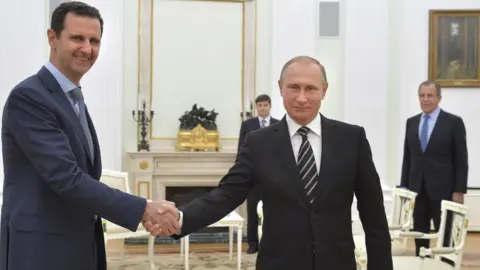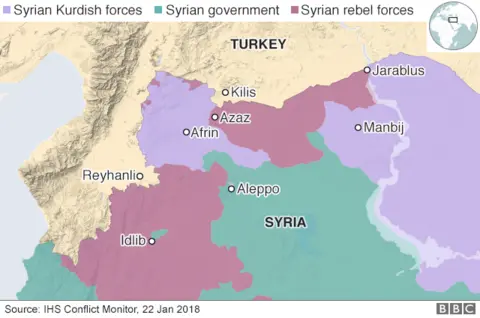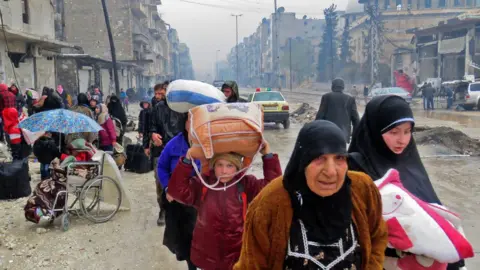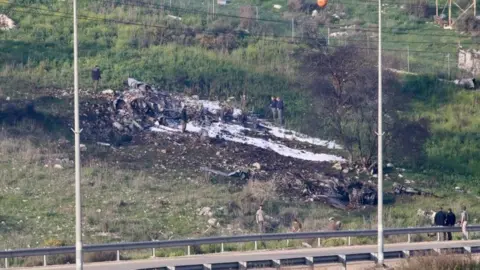Syria conflict: Will powers end up in direct war?
Like all seemingly endless conflicts, the fighting in Syria long ago splintered into a number of mini wars.
The original confrontation between the Syrian government and those trying to bring it down is now almost an irrelevance, with President Assad's position radically diminished but essentially unchallenged - while the very term rebel has become near-obsolete in the Syrian context.
But where this might once have left a void, there is now a dizzying array of competing forces choking up the huge swathes of territory still beyond government control.
The outside sponsors of those forces have moved through the years of the conflict from diplomacy to outright military intervention.
 Reuters
ReutersRussia and Iran are the most deeply invested - financially, politically and militarily.
They have accordingly gained the most in power and influence, but lost the most in fighters on the battlefield, and in the massive economic cost of rescuing President Assad from defeat.
The US has ventured far less, never fully committing to genuine support of the rebels beyond rhetoric and handouts. The result has been a vertiginous fall in its ability to call the shots, and a lack of clarity about its goals.

Turkey has been another major player - originally in its support of the rebels, but more recently in its determination to stop Syrian Kurds from carving out a mini state on its border - by launching a major incursion into northern Syria.
To the south, Israel has sat out most of the conflict, loath to be drawn in - to the disastrous extent that it was during the 16 years of the civil war in Syria's neighbour, Lebanon. It has mostly limited itself to targeted attacks on alleged Iranian bases and suspected Hezbollah arms supplies.
Through much of the conflict, the interests of these outside players were often opposed to each other - and the fact that their aims were mutually exclusive has ensured the failure of all attempts to end the war.
But even as their interests have edged closer to collision, these outside powers have had the buffer of working through their proxy forces on the ground.
When dangerous flashpoints have arisen, all sides have taken a step back to avoid further escalation, leaving Syrians - as ever - to suffer the consequences.
Shared purpose
The rise of the so-called Islamic State group (IS) may have introduced an even darker and more savage dimension to the conflict. But it also brought the temporary relief of a shared purpose in the effort to defeat the one combatant so iniquitous that almost every participant in the war finally saw it as their enemy.
The US and the Russians and Iranians, the Turkish and the Kurds, even the regime, put their irreconcilable differences on hold just long enough to allow them to take on IS - if not as allies, at least not as battlefield rivals.
The concerted power of the forces massed against IS inevitably proved too much for the jihadists, who lost their territory and returned to insurgency.
But all the while this monumental battle was going on, it was actively creating new complications for the post-IS future.
The Kurds with US backing took over more territory as they drove IS out - raising concern in Turkey over their growing power, to fever pitch.
The Russians and Iranians entrenched themselves deeper in Syria - as the regime continued to recover more territory.
After the defeat of IS, the US was left with little clarity to its mission in Syria - and even less influence.
Israel saw battle-hardened Hezbollah and Iranian fighters move closer and closer to its border - prompting a more active, though still cautious, engagement in the conflict.
 AFP
AFPTalk of peace and de-escalation zones has grown in volume, but in many parts of Syria, it's still drowned out by the sound of shelling and aerial bombardment.
Risk of deeper confrontation
It may seem strange to talk of instability in Syria as if it's some new element in the war.
But the increasing international commitment on its various battlefields runs the risk of shifting it from a war between proxies to one directly between the powers pulling the strings. And that is a highly dangerous development.
Recent events have shown that the limited comfort that those involved will always pull back from the brink of deeper confrontation, may not be entirely reliable.
 Reuters
ReutersAn Israeli fighter jet was shot down over Israel by a Syrian missile, following the interception of an Iranian drone in Israeli airspace as part of a ratcheting up of tensions in the hitherto quieter south of Syria.
This happened amid reports of the US killing Russian mercenaries advancing against a US-Kurdish base, even as Turkey's war on the Syrian Kurds pits it squarely against the Americans, who are its NATO allies.
If nothing else, all this may only prolong the Syria war. But it raises fears of all-out confrontation between the outside players - all of whose interests remain as fundamentally opposed as they have been at any time in the conflict.
